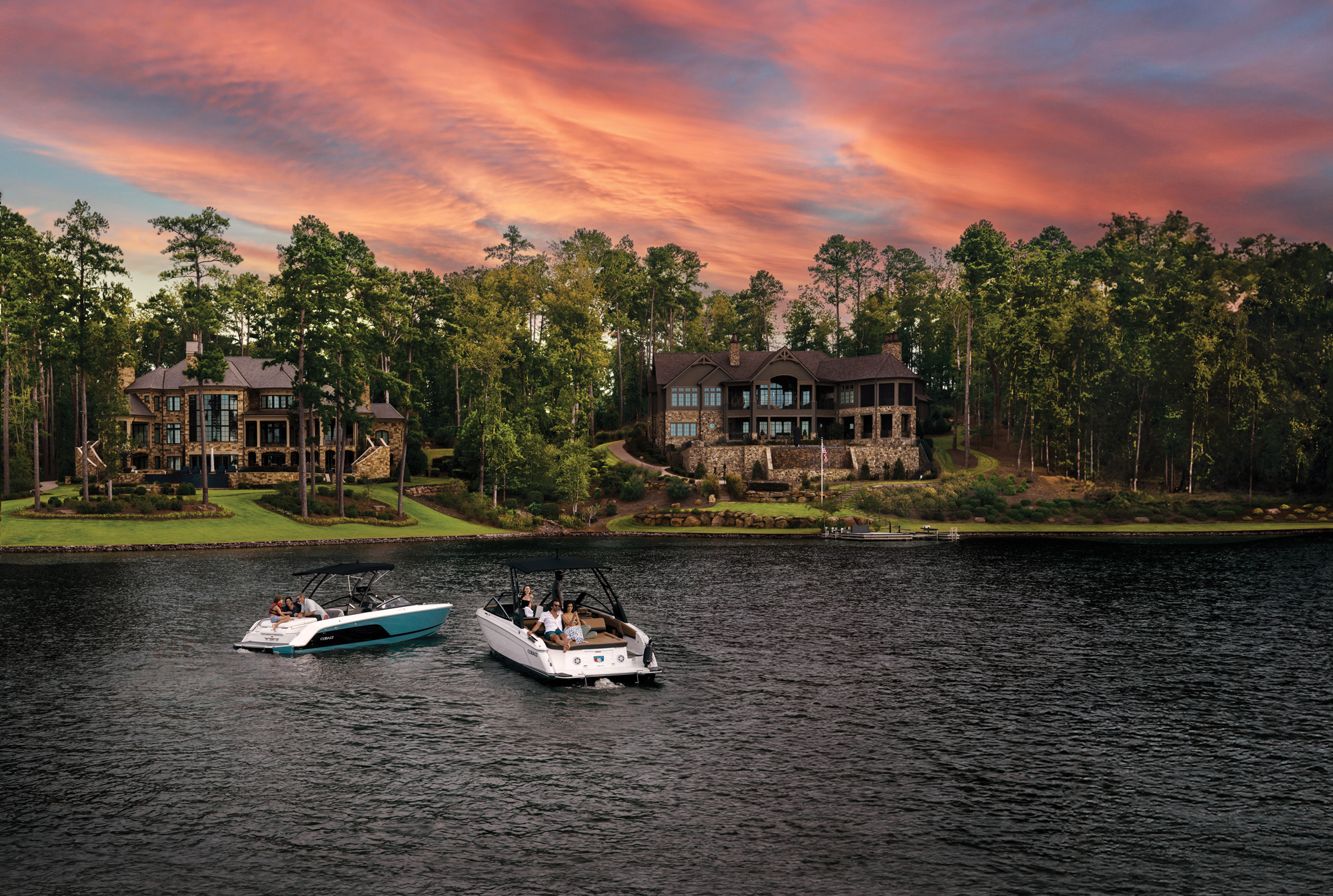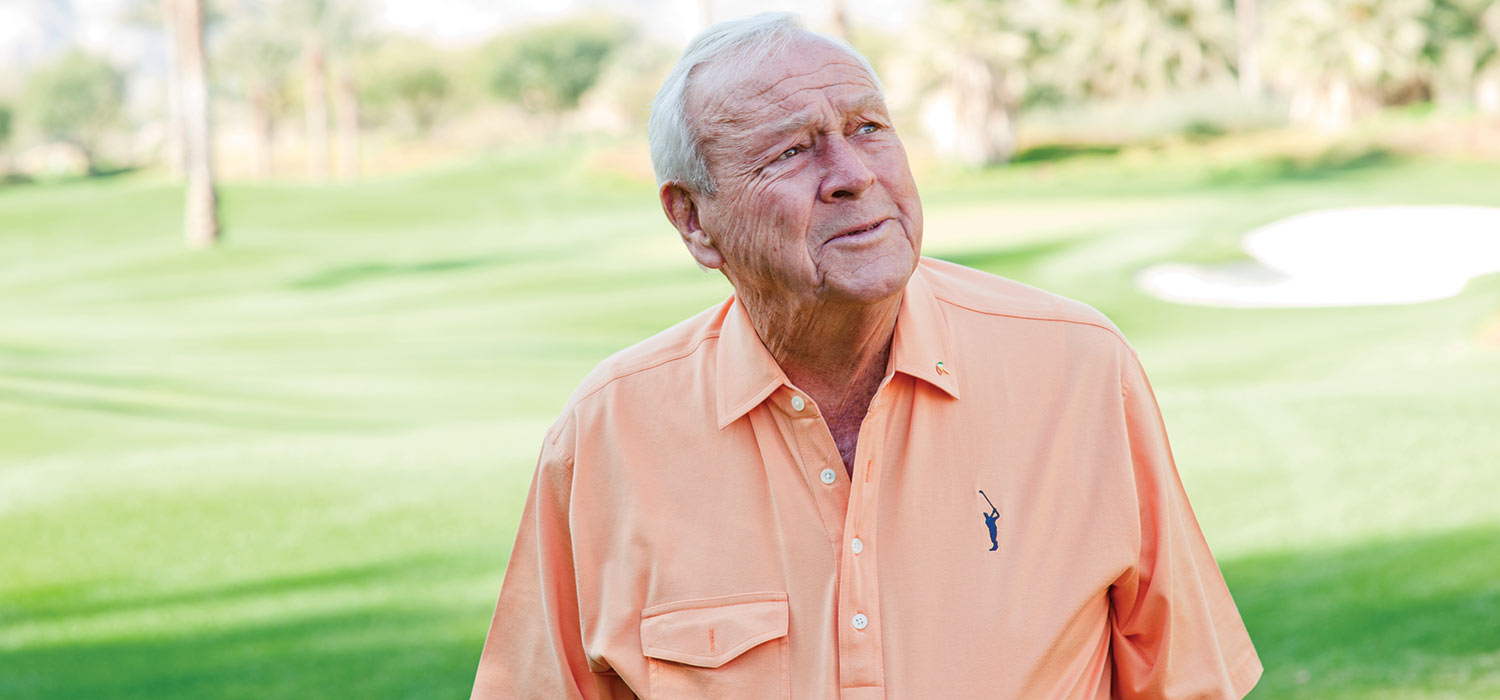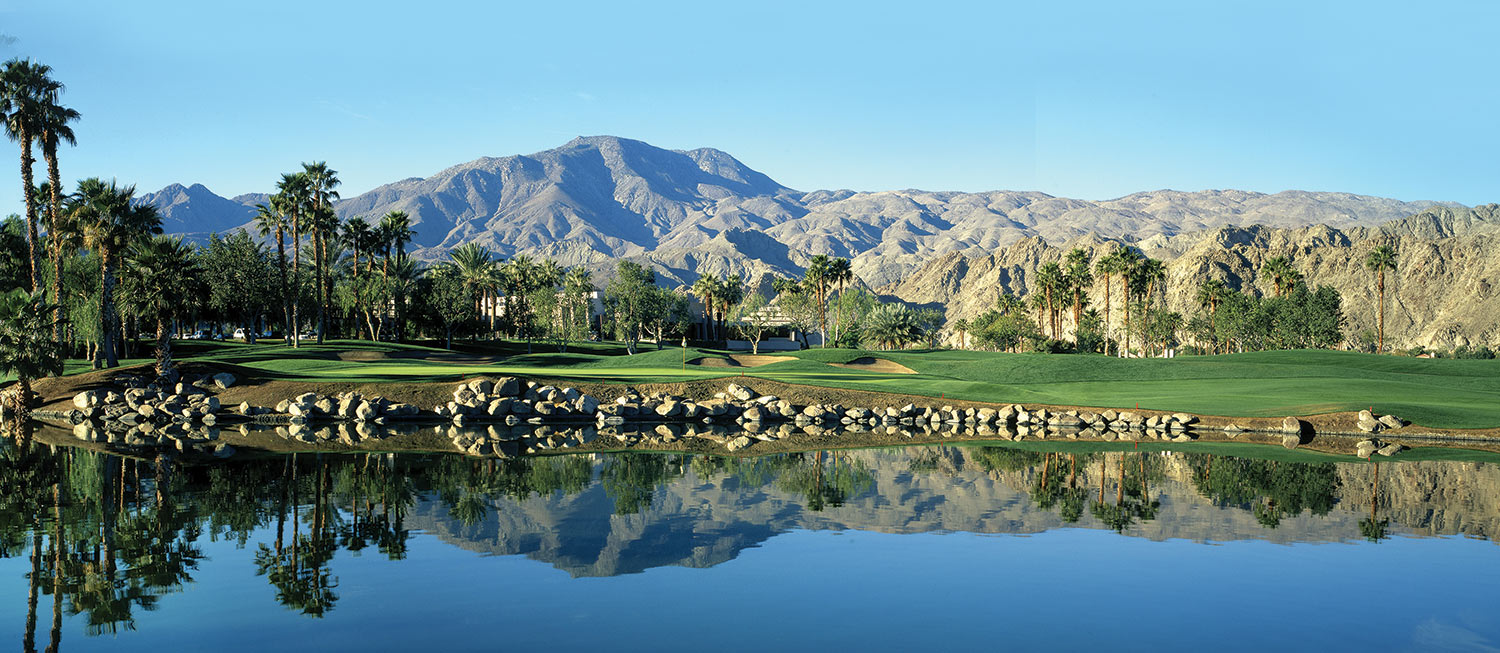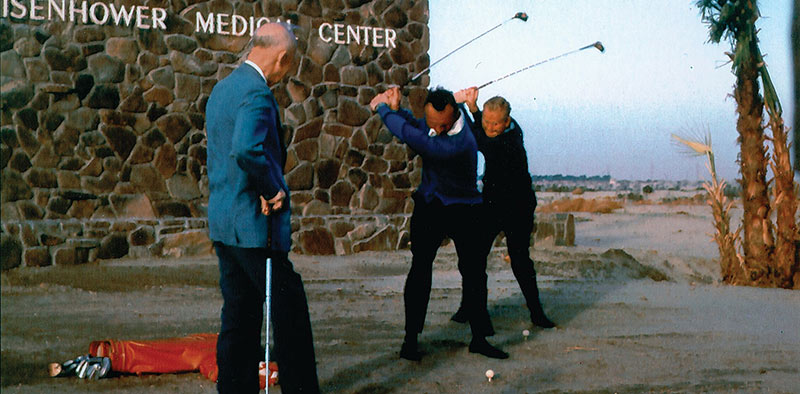
It was the setting for one of his biggest collection of wins, the site of interactions with celebrities and U.S. Presidents. It holds a restaurant named for him, some of his best golf course designs and even a place he called home. Arnold Palmer won in the desert, he worked in the desert, he lived in the desert, and he played in the desert. A world away from his homes in Pennsylvania and Florida, Palmer made his mark in the sand, but it might as well have been in stone
In 1973, on the fifth day of the Bob Hope Desert Classic, Arnold Palmer stood in the rain eight feet from the hole on the 18th green at Bermuda Dunes, staring down a chance at birdie and victory. Playing without his rain suit, which he’d ditched earlier in the day, Palmer made the shot for a closing round 69, hurled his visor over the crowd and celebrated what turned out to be his 62nd and last win on the PGA Tour’s regular season (see sidebar: “Palmer’s 62nd”). It was a fitting setting—and a fitting audience.
Over its history, “The Hope” was known primarily for the celebrities who attended to play or to watch, and 1973 wasn’t short of those: executives Oscar Mayer and Harold Florsheim; singers Frank Sinatra and Glen Campbell; athletes Al Kaline and John Hadl; Bob Hope himself, of course, and numerous others were on hand to see history made in the rain. Vice President Spiro Agnew—a former pro-am partner of Palmer’s at the event—was meant to be there but had to be away to deal with the cease-fire in Vietnam. “I think my not playing is part of the cease-fire,” the Vice President said, according to a PGATOUR.com article by Jim McCabe, while Hope joked that Agnew’s absence helped Palmer’s great play.

But then Palmer had always played well here—when he was able. In his rookie year of 1955, Palmer hitched the trailer to his car and drove to the desert with Winnie, with whom he’d eloped just days before the Christmas of 1954. He wasn’t eligible to play what was then called the Thunderbird Invitational but he wanted to see what it was all about. The following year he was in the tournament, and in 1959, one year after winning the first of his four Masters titles, he took his first victory under the desert sun, with a thrilling final round 62, tying the course record.
Palm Springs Life magazine reported that the Thunderbird Country Club, host to the Invitational and to the 1955 Ryder Cup, saw nearly 5,000 people show up to see Palmer play that year—2,000 more than had showed to watch the Ryder competition.
The following year the tournament changed its name to the Palm Springs Desert Golf Classic and Palmer won the inaugural version of that, then took it again in 1962. Three desert victories under his belt, Palmer kept going after his friend Bob Hope took over as host in 1965. Victories in 1968 and ’71, and his final win in ’73, brought his Desert Classic total to five and his desert victory total to six. No one else has equaled five victories here, and Palmer won no other event as many times.
An ambassador for the tournament as much as he was a competitor in it, Palmer played in 42 Desert Classics over 43 years, missing it only in 1997 when he underwent surgery for prostate cancer. In 2001, the second-to-last year in which he appeared in the tournament, Palmer became the first pro in 22 years to shoot his age, making a 1-under 71 on the course he designed at PGA West.

That the moment came on a course Palmer designed might not be so surprising when one considers how many great desert area courses bear his name. The course on which he shot a 71 in 2001, The Palmer Course at PGA West, has a stunning array of five finishing holes carved among the rugged Santa Rosa Mountains, which played a starring role in David Duval’s 1999 victory in the Bob Hope Chrysler Classic. After getting out of the bunker and making a 10-foot birdie putt on No.14, Duval went birdie, birdie, par before facing an 8-foot putt for eagle on the par-5 18th. He made it—and set the course record, at the time becoming only the third player in PGA Tour history to shoot 59 (as of press time, nine have done it, including Jim Furyk, who’s also shot a 58). Another great area design by Palmer is at Tradition Golf Club in La Quinta, where Palmer also had a home. Known for its pristine course condition and stunningly colorful landscaping (Palmer insisted, as Winnie loved floral displays), golfcoursegurus.com said that the course here “reminds you why you fell in love with golf in the first place.” Bighorn sheep on the back nine are a plus for nature-lovers, and the breathtaking view from the elevated tee at No.17 will give anyone pleasant pause. Classic Club is another gem, 18 holes designed around a 63,000 Tuscan-inspired clubhouse, and host to the Bob Hope Classic from 2006–08. A proper oasis in the desert, it features 30 acres of water features and 14 bridges, making for a worthwhile escape for sand-weary visitors. There’s Indian Ridge, Mission Hills, Mountain View, SilverRock Resort (host to the Bob Hope Classic since 2008)… The list goes on. Ironwood Country Club, in Palm Desert, is another place where Palmer stamped his name on the desert, though this time as a consultant rather than course designer. The afternoon before they teed it up against each other in the 1973 Bob Hope, Palmer and Nicklaus drove two golf balls into Deep Canyon as part of ground-breaking ceremonies for the club, which opened the following year.

Beyond business and golf, Palmer also found time to relax and to enjoy the company of friends in the desert. Among other celebrities, this included visiting President Dwight D. Eisenhower at his Palm Springs home. President Eisenhower was a desert fixture, frequently seen at The Hope and forever remembered in Eisenhower Health (formerly the Eisenhower Medical Center). Today, in front of the center, Arnold Palmer has a “Golden Palm Star” on the Palm Springs Walk of Stars.” Closer to his home at Tradition, since 2004 Palmer’s name has adorned Arnold Palmer’s Restaurant, a friendly upscale eatery in La Quinta that offers some of Arnie’s favorites (such as Arnie’s Homemade Meatloaf) and a top-notch wine list, impressively manifested in The Wine Room, available for special events and showcasing more than 2,000 bottles of the good stuff. There’s also a substantive collection of one-of-a-kind Palmer memorabilia and photos on display, most of it in the incredible Palmer Room, making the restaurant a perfect stop for fans in the area.
There’s more: The Nest restaurant in Indian Wells, which Palmer liked; a Palmer statue at Tradition, one of only three of the type (the other two are on display at Wake Forest and at Bay Hill Club & Lodge); “Arnold Palmer Day,” which La Quinta started celebrating in 2014, and plenty more. For the man who left an impression anywhere he visited, the desert provided ample opportunity for impact—and he left it better than he found it.
“I just like it,” Palmer had said of the Greater Palm Springs area. “I came here in 1955 and I never left.”
Thanks to a legacy of fantastic area achievements, he never will.
In any other year it would have been madness to bet against Arnold Palmer, but in 1973 anyone looking for a mid-winter wager could have been forgiven for hesitating to put his money on the champ from Pennsylvania. Going into the 1973 Bob Hope Desert Classic, Palmer had 61 PGA Tour victories behind him. But he was 43 years old, he hadn’t won since July of 1971 (the Westchester Classic) and it seemed that his putting had gotten away from him. Woes on the greens largely were blamed for the fact that 1972 had been Palmer’s first tour year without a professional victory, bringing to a close his streak of 17 consecutive seasons with a win (currently Jack Nicklaus is tied with Palmer for the most; Billy Casper is second with 16, Lee Trevino and Tiger Woods are third with 14).
The opening round of “The Hope” wouldn’t have inspired much confidence: Palmer shot 71 to Jack Nicklaus’ 64 and looked set for another frustrating performance. But Arnie regrouped for a second-round 66 and then made 69 in the third, leaving him at 206 and just one shot behind co-leaders Nicklaus and Alan Miller, the former University of Georgia standout then starting his third year on tour and looking for a first pro win.
The fourth round (of a then-five-round tournament) brought more drama with Palmer making 68 to stay one back of Nicklaus, while fireworks came from another Miller—Johnny—who carded 63 to tie Nicklaus for the lead at 273. Miller would go on to win that year’s U.S. Open in June at Oakmont Country Club near Pittsburgh, not far from Palmer’s hometown of Latrobe.
The stage was set already for a landmark finish but the weather decided to up the ante, dumping heavy rain on the desert on the morning of the fifth round. Rather than dampening spirits the storm seemed to produce vintage form from Palmer, who opened with a birdie. Nicklaus three-putted the sixth, Palmer jumped in front and by No.9 Arnie led by two strokes. At 16 he made a nine-footer to save par while Nicklaus missed his three-footer for birdie, and it seemed the end was in sight. But Jack hit the 18th in two to set up an eagle try and so it went down to the final moments. Having ditched his rain suit, Palmer stood in tinted glasses, his broad collar extending over the neck of his sweater, and watched as Nicklaus fired his putt past the cup. Jack’s valiant attempt done, it was seven feet to victory for Arnie and he made it in fine style, nailing his birdie in the rain and then heaving his visor into the air over an adoring, cheering crowd. His closing 69 was “one of my best finishing rounds,” he would go on to tell the media. Though no one knew it at the time, it would also be his last win on TOUR. Following his 50th birthday, Palmer won 10 PGA TOUR Champions events and his career off-course went on to define the game of golf and so much more, but on a rainy day in the desert in 1973, an era came to a close.
Follow Us On


| Cookie | Duration | Description |
|---|---|---|
| cookielawinfo-checkbox-analytics | 11 months | This cookie is set by GDPR Cookie Consent plugin. The cookie is used to store the user consent for the cookies in the category "Analytics". |
| cookielawinfo-checkbox-functional | 11 months | The cookie is set by GDPR cookie consent to record the user consent for the cookies in the category "Functional". |
| cookielawinfo-checkbox-necessary | 11 months | This cookie is set by GDPR Cookie Consent plugin. The cookies is used to store the user consent for the cookies in the category "Necessary". |
| cookielawinfo-checkbox-others | 11 months | This cookie is set by GDPR Cookie Consent plugin. The cookie is used to store the user consent for the cookies in the category "Other. |
| cookielawinfo-checkbox-performance | 11 months | This cookie is set by GDPR Cookie Consent plugin. The cookie is used to store the user consent for the cookies in the category "Performance". |
| viewed_cookie_policy | 11 months | The cookie is set by the GDPR Cookie Consent plugin and is used to store whether or not user has consented to the use of cookies. It does not store any personal data. |